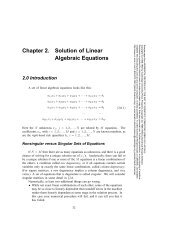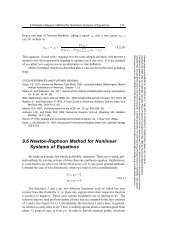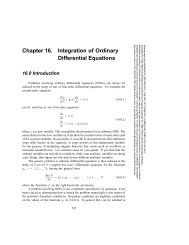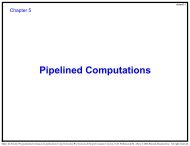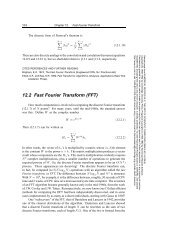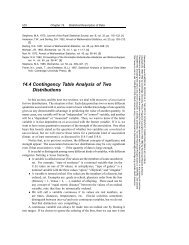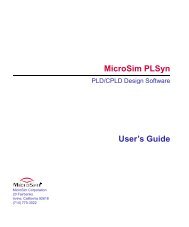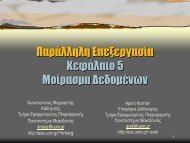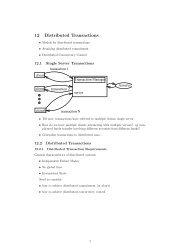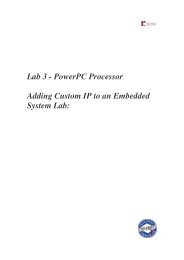SVD-Numerical Recipe in C - 3MAP
SVD-Numerical Recipe in C - 3MAP
SVD-Numerical Recipe in C - 3MAP
Create successful ePaper yourself
Turn your PDF publications into a flip-book with our unique Google optimized e-Paper software.
2.6 S<strong>in</strong>gular Value Decomposition 59<br />
2.6 S<strong>in</strong>gular Value Decomposition<br />
There exists a very powerful set of techniques for deal<strong>in</strong>g with sets of equations<br />
or matrices that are either s<strong>in</strong>gular or else numerically very close to s<strong>in</strong>gular. In many<br />
cases where Gaussian elim<strong>in</strong>ation and LU decomposition fail to give satisfactory<br />
results, this set of techniques, known as s<strong>in</strong>gular value decomposition, or<strong>SVD</strong>,<br />
will diagnose for you precisely what the problem is. In some cases, <strong>SVD</strong> will<br />
not only diagnose the problem, it will also solve it, <strong>in</strong> the sense of giv<strong>in</strong>g you a<br />
useful numerical answer, although, as we shall see, not necessarily “the” answer<br />
that you thought you should get.<br />
<strong>SVD</strong> is also the method of choice for solv<strong>in</strong>g most l<strong>in</strong>ear least-squares problems.<br />
We will outl<strong>in</strong>e the relevant theory <strong>in</strong> this section, but defer detailed discussion of<br />
the use of <strong>SVD</strong> <strong>in</strong> this application to Chapter 15, whose subject is the parametric<br />
model<strong>in</strong>g of data.<br />
<strong>SVD</strong> methods are based on the follow<strong>in</strong>g theorem of l<strong>in</strong>ear algebra, whose proof<br />
is beyond our scope: Any M × N matrix A whose number of rows M is greater than<br />
or equal to its number of columns N, can be written as the product of an M × N<br />
column-orthogonal matrix U, anN × N diagonal matrix W with positive or zero<br />
elements (the s<strong>in</strong>gular values), and the transpose of an N × N orthogonal matrix V.<br />
The various shapes of these matrices will be made clearer by the follow<strong>in</strong>g tableau:<br />
⎛<br />
⎜<br />
⎝<br />
A<br />
⎞ ⎛<br />
=<br />
⎟ ⎜<br />
⎠ ⎝<br />
U<br />
⎞<br />
⎛<br />
w 1 ⎜ w 2 · ⎝ ···<br />
···<br />
⎟<br />
⎠<br />
⎞<br />
⎟<br />
⎠ ·<br />
w N<br />
⎛<br />
⎞<br />
⎜<br />
⎝ V T ⎟<br />
⎠<br />
(2.6.1)<br />
The matrices U and V are each orthogonal <strong>in</strong> the sense that their columns are<br />
orthonormal,<br />
M∑<br />
U ik U <strong>in</strong> = δ kn<br />
i=1<br />
N∑<br />
V jk V jn = δ kn<br />
j=1<br />
1 ≤ k ≤ N<br />
1 ≤ n ≤ N<br />
1 ≤ k ≤ N<br />
1 ≤ n ≤ N<br />
(2.6.2)<br />
(2.6.3)<br />
Sample page from NUMERICAL RECIPES IN C: THE ART OF SCIENTIFIC COMPUTING (ISBN 0-521-43108-5)<br />
Copyright (C) 1988-1992 by Cambridge University Press. Programs Copyright (C) 1988-1992 by <strong>Numerical</strong> <strong>Recipe</strong>s Software.<br />
Permission is granted for <strong>in</strong>ternet users to make one paper copy for their own personal use. Further reproduction, or any copy<strong>in</strong>g of mach<strong>in</strong>ereadable<br />
files (<strong>in</strong>clud<strong>in</strong>g this one) to any server computer, is strictly prohibited. To order <strong>Numerical</strong> <strong>Recipe</strong>s books or CDROMs, visit website<br />
http://www.nr.com or call 1-800-872-7423 (North America only), or send email to directcustserv@cambridge.org (outside North America).
60 Chapter 2. Solution of L<strong>in</strong>ear Algebraic Equations<br />
or as a tableau,<br />
⎛<br />
⎜<br />
⎝<br />
U T<br />
⎛<br />
⎞<br />
⎟<br />
⎠ ·<br />
⎜<br />
⎝<br />
U<br />
⎞<br />
⎛<br />
=<br />
⎜<br />
⎝<br />
⎟<br />
⎠<br />
⎛<br />
=<br />
⎜<br />
⎝<br />
V T<br />
1<br />
⎞ ⎛<br />
⎟<br />
⎠ ·<br />
⎜<br />
⎝<br />
⎞<br />
⎟<br />
⎠<br />
V<br />
⎞<br />
⎟<br />
⎠<br />
(2.6.4)<br />
S<strong>in</strong>ce V is square, it is also row-orthonormal, V · V T =1.<br />
The <strong>SVD</strong> decomposition can also be carried out when M
2.6 S<strong>in</strong>gular Value Decomposition 61<br />
<strong>SVD</strong> of a Square Matrix<br />
If the matrix A is square, N × N say, then U, V, and W are all square matrices<br />
of the same size. Their <strong>in</strong>verses are also trivial to compute: U and V are orthogonal,<br />
so their <strong>in</strong>verses are equal to their transposes; W is diagonal, so its <strong>in</strong>verse is the<br />
diagonal matrix whose elements are the reciprocals of the elements w j . From (2.6.1)<br />
it now follows immediately that the <strong>in</strong>verse of A is<br />
A −1 = V · [diag (1/w j )] · U T (2.6.5)<br />
The only th<strong>in</strong>g that can go wrong with this construction is for one of the w j ’s<br />
to be zero, or (numerically) for it to be so small that its value is dom<strong>in</strong>ated by<br />
roundoff error and therefore unknowable. If more than one of the w j ’s have this<br />
problem, then the matrix is even more s<strong>in</strong>gular. So, first of all, <strong>SVD</strong> gives you a<br />
clear diagnosis of the situation.<br />
Formally, the condition number of a matrix is def<strong>in</strong>ed as the ratio of the largest<br />
(<strong>in</strong> magnitude) of the w j ’s to the smallest of the w j ’s. A matrix is s<strong>in</strong>gular if its<br />
condition number is <strong>in</strong>f<strong>in</strong>ite, and it is ill-conditioned if its condition number is too<br />
large, that is, if its reciprocal approaches the mach<strong>in</strong>e’s float<strong>in</strong>g-po<strong>in</strong>t precision (for<br />
example, less than 10 −6 for s<strong>in</strong>gle precision or 10 −12 for double).<br />
For s<strong>in</strong>gular matrices, the concepts of nullspace and range are important.<br />
Consider the familiar set of simultaneous equations<br />
A · x = b (2.6.6)<br />
where A is a square matrix, b and x are vectors. Equation (2.6.6) def<strong>in</strong>es A as a<br />
l<strong>in</strong>ear mapp<strong>in</strong>g from the vector space x to the vector space b. IfA is s<strong>in</strong>gular, then<br />
there is some subspace of x, called the nullspace, that is mapped to zero, A · x =0.<br />
The dimension of the nullspace (the number of l<strong>in</strong>early <strong>in</strong>dependent vectors x that<br />
can be found <strong>in</strong> it) is called the nullity of A.<br />
Now, there is also some subspace of b that can be “reached” by A, <strong>in</strong> the sense<br />
that there exists some x which is mapped there. This subspace of b is called the range<br />
of A. The dimension of the range is called the rank of A. IfA is nons<strong>in</strong>gular, then its<br />
range will be all of the vector space b, so its rank is N. IfA is s<strong>in</strong>gular, then the rank<br />
will be less than N. In fact, the relevant theorem is “rank plus nullity equals N.”<br />
What has this to do with <strong>SVD</strong> <strong>SVD</strong> explicitly constructs orthonormal bases<br />
for the nullspace and range of a matrix. Specifically, the columns of U whose<br />
same-numbered elements w j are nonzero are an orthonormal set of basis vectors that<br />
span the range; the columns of V whose same-numbered elements w j are zero are<br />
an orthonormal basis for the nullspace.<br />
Now let’s have another look at solv<strong>in</strong>g the set of simultaneous l<strong>in</strong>ear equations<br />
(2.6.6) <strong>in</strong> the case that A is s<strong>in</strong>gular. First, the set of homogeneous equations, where<br />
b =0, is solved immediately by <strong>SVD</strong>: Any column of V whose correspond<strong>in</strong>g w j<br />
is zero yields a solution.<br />
When the vector b on the right-hand side is not zero, the important question is<br />
whether it lies <strong>in</strong> the range of A or not. If it does, then the s<strong>in</strong>gular set of equations<br />
does have a solution x; <strong>in</strong> fact it has more than one solution, s<strong>in</strong>ce any vector <strong>in</strong><br />
the nullspace (any column of V with a correspond<strong>in</strong>g zero w j ) can be added to x<br />
<strong>in</strong> any l<strong>in</strong>ear comb<strong>in</strong>ation.<br />
Sample page from NUMERICAL RECIPES IN C: THE ART OF SCIENTIFIC COMPUTING (ISBN 0-521-43108-5)<br />
Copyright (C) 1988-1992 by Cambridge University Press. Programs Copyright (C) 1988-1992 by <strong>Numerical</strong> <strong>Recipe</strong>s Software.<br />
Permission is granted for <strong>in</strong>ternet users to make one paper copy for their own personal use. Further reproduction, or any copy<strong>in</strong>g of mach<strong>in</strong>ereadable<br />
files (<strong>in</strong>clud<strong>in</strong>g this one) to any server computer, is strictly prohibited. To order <strong>Numerical</strong> <strong>Recipe</strong>s books or CDROMs, visit website<br />
http://www.nr.com or call 1-800-872-7423 (North America only), or send email to directcustserv@cambridge.org (outside North America).
62 Chapter 2. Solution of L<strong>in</strong>ear Algebraic Equations<br />
If we want to s<strong>in</strong>gle out one particular member of this solution-set of vectors as<br />
a representative, we might want to pick the one with the smallest length |x| 2 . Here is<br />
how to f<strong>in</strong>d that vector us<strong>in</strong>g <strong>SVD</strong>: Simply replace 1/w j by zero if w j =0. (It is not<br />
very often that one gets to set ∞ =0!) Then compute (work<strong>in</strong>g from right to left)<br />
x = V · [diag (1/w j )] · (U T · b) (2.6.7)<br />
This will be the solution vector of smallest length; the columns of V that are <strong>in</strong> the<br />
nullspace complete the specification of the solution set.<br />
Proof: Consider |x + x ′ |, where x ′ lies <strong>in</strong> the nullspace. Then, if W −1 denotes<br />
the modified <strong>in</strong>verse of W with some elements zeroed,<br />
|x + x ′ | = ∣ ∣ V · W<br />
−1 · U T · b + x ′∣ ∣<br />
= ∣ ∣ V · (W<br />
−1 · U T · b + V T · x ′ ) ∣ ∣<br />
= ∣ ∣ W<br />
−1 · U T · b + V T · x ′∣ ∣<br />
(2.6.8)<br />
Here the first equality follows from (2.6.7), the second and third from the orthonormality<br />
of V. If you now exam<strong>in</strong>e the two terms that make up the sum on the<br />
right-hand side, you will see that the first one has nonzero j components only where<br />
w j ≠0, while the second one, s<strong>in</strong>ce x ′ is <strong>in</strong> the nullspace, has nonzero j components<br />
only where w j =0. Therefore the m<strong>in</strong>imum length obta<strong>in</strong>s for x ′ =0, q.e.d.<br />
If b is not <strong>in</strong> the range of the s<strong>in</strong>gular matrix A, then the set of equations (2.6.6)<br />
has no solution. But here is some good news: If b is not <strong>in</strong> the range of A, then<br />
equation (2.6.7) can still be used to construct a “solution” vector x. This vector x<br />
will not exactly solve A · x = b. But, among all possible vectors x, it will do the<br />
closest possible job <strong>in</strong> the least squares sense. In other words (2.6.7) f<strong>in</strong>ds<br />
x which m<strong>in</strong>imizes r ≡|A · x − b| (2.6.9)<br />
The number r is called the residual of the solution.<br />
The proof is similar to (2.6.8): Suppose we modify x by add<strong>in</strong>g some arbitrary<br />
x ′ . Then A · x − b is modified by add<strong>in</strong>g some b ′ ≡ A · x ′ . Obviously b ′ is <strong>in</strong><br />
the range of A. We then have<br />
∣<br />
∣A · x − b + b ′∣ ∣ = ∣ ∣(U · W · V T ) · (V · W −1 · U T · b) − b + b ′∣ ∣<br />
= ∣ ∣(U · W · W −1 · U T − 1) · b + b ′∣ ∣<br />
= ∣ ∣ U ·<br />
[<br />
(W · W −1 − 1) · U T · b + U T · b ′]∣ ∣<br />
= ∣ ∣ (W · W −1 − 1) · U T · b + U T · b ′∣ ∣<br />
(2.6.10)<br />
Sample page from NUMERICAL RECIPES IN C: THE ART OF SCIENTIFIC COMPUTING (ISBN 0-521-43108-5)<br />
Copyright (C) 1988-1992 by Cambridge University Press. Programs Copyright (C) 1988-1992 by <strong>Numerical</strong> <strong>Recipe</strong>s Software.<br />
Permission is granted for <strong>in</strong>ternet users to make one paper copy for their own personal use. Further reproduction, or any copy<strong>in</strong>g of mach<strong>in</strong>ereadable<br />
files (<strong>in</strong>clud<strong>in</strong>g this one) to any server computer, is strictly prohibited. To order <strong>Numerical</strong> <strong>Recipe</strong>s books or CDROMs, visit website<br />
http://www.nr.com or call 1-800-872-7423 (North America only), or send email to directcustserv@cambridge.org (outside North America).<br />
Now, (W · W −1 − 1) is a diagonal matrix which has nonzero j components only for<br />
w j =0, while U T b ′ has nonzero j components only for w j ≠0, s<strong>in</strong>ce b ′ lies <strong>in</strong> the<br />
range of A. Therefore the m<strong>in</strong>imum obta<strong>in</strong>s for b ′ =0, q.e.d.<br />
Figure 2.6.1 summarizes our discussion of <strong>SVD</strong> thus far.
2.6 S<strong>in</strong>gular Value Decomposition 63<br />
A<br />
solutions of<br />
A ⋅ x = d<br />
null<br />
space<br />
of A<br />
<strong>SVD</strong> solution of<br />
A ⋅ x = d<br />
x<br />
solutions of<br />
A ⋅ x = c′<br />
A ⋅ x = b<br />
(a)<br />
<strong>SVD</strong> “solution”<br />
of A ⋅ x = c<br />
(b)<br />
range of A<br />
Figure 2.6.1. (a) A nons<strong>in</strong>gular matrix A maps a vector space <strong>in</strong>to one of the same dimension. The<br />
vector x is mapped <strong>in</strong>to b, so that x satisfies the equation A · x = b. (b) A s<strong>in</strong>gular matrix A maps a<br />
vector space <strong>in</strong>to one of lower dimensionality, here a plane <strong>in</strong>to a l<strong>in</strong>e, called the “range” of A. The<br />
“nullspace” of A is mapped to zero. The solutions of A · x = d consist of any one particular solution plus<br />
any vector <strong>in</strong> the nullspace, here form<strong>in</strong>g a l<strong>in</strong>e parallel to the nullspace. S<strong>in</strong>gular value decomposition<br />
(<strong>SVD</strong>) selects the particular solution closest to zero, as shown. The po<strong>in</strong>t c lies outside of the range<br />
of A, soA · x = c has no solution. <strong>SVD</strong> f<strong>in</strong>ds the least-squares best compromise solution, namely a<br />
solution of A · x = c ′ , as shown.<br />
In the discussion s<strong>in</strong>ce equation (2.6.6), we have been pretend<strong>in</strong>g that a matrix<br />
either is s<strong>in</strong>gular or else isn’t. That is of course true analytically. <strong>Numerical</strong>ly,<br />
however, the far more common situation is that some of the w j ’s are very small<br />
but nonzero, so that the matrix is ill-conditioned. In that case, the direct solution<br />
methods of LU decomposition or Gaussian elim<strong>in</strong>ation may actually give a formal<br />
solution to the set of equations (that is, a zero pivot may not be encountered); but<br />
the solution vector may have wildly large components whose algebraic cancellation,<br />
when multiply<strong>in</strong>g by the matrix A, may give a very poor approximation to the<br />
right-hand vector b. In such cases, the solution vector x obta<strong>in</strong>ed by zero<strong>in</strong>g the<br />
d<br />
b<br />
c′<br />
c<br />
Sample page from NUMERICAL RECIPES IN C: THE ART OF SCIENTIFIC COMPUTING (ISBN 0-521-43108-5)<br />
Copyright (C) 1988-1992 by Cambridge University Press. Programs Copyright (C) 1988-1992 by <strong>Numerical</strong> <strong>Recipe</strong>s Software.<br />
Permission is granted for <strong>in</strong>ternet users to make one paper copy for their own personal use. Further reproduction, or any copy<strong>in</strong>g of mach<strong>in</strong>ereadable<br />
files (<strong>in</strong>clud<strong>in</strong>g this one) to any server computer, is strictly prohibited. To order <strong>Numerical</strong> <strong>Recipe</strong>s books or CDROMs, visit website<br />
http://www.nr.com or call 1-800-872-7423 (North America only), or send email to directcustserv@cambridge.org (outside North America).
64 Chapter 2. Solution of L<strong>in</strong>ear Algebraic Equations<br />
small w j ’s and then us<strong>in</strong>g equation (2.6.7) is very often better (<strong>in</strong> the sense of the<br />
residual |A · x − b| be<strong>in</strong>g smaller) than both the direct-method solution and the <strong>SVD</strong><br />
solution where the small w j ’s are left nonzero.<br />
It may seem paradoxical that this can be so, s<strong>in</strong>ce zero<strong>in</strong>g a s<strong>in</strong>gular value<br />
corresponds to throw<strong>in</strong>g away one l<strong>in</strong>ear comb<strong>in</strong>ation of the set of equations that<br />
we are try<strong>in</strong>g to solve. The resolution of the paradox is that we are throw<strong>in</strong>g away<br />
precisely a comb<strong>in</strong>ation of equations that is so corrupted by roundoff error as to be at<br />
best useless; usually it is worse than useless s<strong>in</strong>ce it “pulls” the solution vector way<br />
off towards <strong>in</strong>f<strong>in</strong>ity along some direction that is almost a nullspace vector. In do<strong>in</strong>g<br />
this, it compounds the roundoff problem and makes the residual |A · x − b| larger.<br />
<strong>SVD</strong> cannot be applied bl<strong>in</strong>dly, then. You have to exercise some discretion <strong>in</strong><br />
decid<strong>in</strong>g at what threshold to zero the small w j ’s, and/or you have to have some idea<br />
what size of computed residual |A · x − b| is acceptable.<br />
As an example, here is a “backsubstitution” rout<strong>in</strong>e svbksb for evaluat<strong>in</strong>g<br />
equation (2.6.7) and obta<strong>in</strong><strong>in</strong>g a solution vector x from a right-hand side b, given<br />
that the <strong>SVD</strong> of a matrix A has already been calculated by a call to svdcmp. Note<br />
that this rout<strong>in</strong>e presumes that you have already zeroed the small w j ’s. It does not<br />
do this for you. If you haven’t zeroed the small w j ’s, then this rout<strong>in</strong>e is just as<br />
ill-conditioned as any direct method, and you are misus<strong>in</strong>g <strong>SVD</strong>.<br />
#<strong>in</strong>clude "nrutil.h"<br />
void svbksb(float **u, float w[], float **v, <strong>in</strong>t m, <strong>in</strong>t n, float b[], float x[])<br />
Solves A·X = B for a vector X, whereA is specified by the arrays u[1..m][1..n], w[1..n],<br />
v[1..n][1..n] as returned by svdcmp. m and n are the dimensions of a, and will be equal for<br />
square matrices. b[1..m] is the <strong>in</strong>put right-hand side. x[1..n] is the output solution vector.<br />
No <strong>in</strong>put quantities are destroyed, so the rout<strong>in</strong>e may be called sequentially with different b’s.<br />
{<br />
<strong>in</strong>t jj,j,i;<br />
float s,*tmp;<br />
}<br />
tmp=vector(1,n);<br />
for (j=1;j
2.6 S<strong>in</strong>gular Value Decomposition 65<br />
#def<strong>in</strong>e N ...<br />
float wmax,wm<strong>in</strong>,**a,**u,*w,**v,*b,*x;<br />
<strong>in</strong>t i,j;<br />
...<br />
for(i=1;i
66 Chapter 2. Solution of L<strong>in</strong>ear Algebraic Equations<br />
given by (2.6.7), which, with nonsquare matrices, looks like this,<br />
⎛ ⎞ ⎛<br />
⎜<br />
⎝ x ⎟<br />
⎠ = ⎜<br />
⎝<br />
V<br />
⎞ ⎛ ⎞ ⎛<br />
⎞<br />
⎟<br />
⎠ ·<br />
⎜<br />
⎝ diag(1/w j) ⎟<br />
⎠ ·<br />
⎜<br />
⎝ U T ⎟<br />
⎠ ·<br />
b<br />
⎜ ⎟<br />
⎝ ⎠<br />
(2.6.12)<br />
In general, the matrix W will not be s<strong>in</strong>gular, and no w j ’s will need to be<br />
set to zero. Occasionally, however, there might be column degeneracies <strong>in</strong> A. In<br />
this case you will need to zero some small w j values after all. The correspond<strong>in</strong>g<br />
column <strong>in</strong> V gives the l<strong>in</strong>ear comb<strong>in</strong>ation of x’s that is then ill-determ<strong>in</strong>ed even by<br />
the supposedly overdeterm<strong>in</strong>ed set.<br />
Sometimes, although you do not need to zero any w j ’s for computational<br />
reasons, you may nevertheless want to take note of any that are unusually small:<br />
Their correspond<strong>in</strong>gcolumns <strong>in</strong> V are l<strong>in</strong>ear comb<strong>in</strong>ations of x’s which are <strong>in</strong>sensitive<br />
to your data. In fact, you may then wish to zero these w j ’s, to reduce the number of<br />
free parameters <strong>in</strong> the fit. These matters are discussed more fully <strong>in</strong> Chapter 15.<br />
Construct<strong>in</strong>g an Orthonormal Basis<br />
Suppose that you have N vectors <strong>in</strong> an M-dimensional vector space, with<br />
N ≤ M. Then the N vectors span some subspace of the full vector space.<br />
Often you want to construct an orthonormal set of N vectors that span the same<br />
subspace. The textbook way to do this is by Gram-Schmidt orthogonalization,<br />
start<strong>in</strong>g with one vector and then expand<strong>in</strong>g the subspace one dimension at a<br />
time. <strong>Numerical</strong>ly, however, because of the build-up of roundoff errors, naive<br />
Gram-Schmidt orthogonalization is terrible.<br />
The right way to construct an orthonormal basis for a subspace is by <strong>SVD</strong>:<br />
Form an M × N matrix A whose N columns are your vectors. Run the matrix<br />
through svdcmp. The columns of the matrix U (which <strong>in</strong> fact replaces A on output<br />
from svdcmp) are your desired orthonormal basis vectors.<br />
You might also want to check the output w j ’s for zero values. If any occur,<br />
then the spanned subspace was not, <strong>in</strong> fact, N dimensional; the columns of U<br />
correspond<strong>in</strong>g to zero w j ’s should be discarded from the orthonormal basis set.<br />
(QR factorization, discussed <strong>in</strong> §2.10, also constructs an orthonormal basis,<br />
see [5].)<br />
Approximation of Matrices<br />
Note that equation (2.6.1) can be rewritten to express any matrix A ij as a sum<br />
of outer products of columns of U and rows of V T , with the “weight<strong>in</strong>g factors”<br />
be<strong>in</strong>g the s<strong>in</strong>gular values w j ,<br />
N∑<br />
A ij = w k U ik V jk (2.6.13)<br />
k=1<br />
⎛<br />
⎞<br />
Sample page from NUMERICAL RECIPES IN C: THE ART OF SCIENTIFIC COMPUTING (ISBN 0-521-43108-5)<br />
Copyright (C) 1988-1992 by Cambridge University Press. Programs Copyright (C) 1988-1992 by <strong>Numerical</strong> <strong>Recipe</strong>s Software.<br />
Permission is granted for <strong>in</strong>ternet users to make one paper copy for their own personal use. Further reproduction, or any copy<strong>in</strong>g of mach<strong>in</strong>ereadable<br />
files (<strong>in</strong>clud<strong>in</strong>g this one) to any server computer, is strictly prohibited. To order <strong>Numerical</strong> <strong>Recipe</strong>s books or CDROMs, visit website<br />
http://www.nr.com or call 1-800-872-7423 (North America only), or send email to directcustserv@cambridge.org (outside North America).
2.6 S<strong>in</strong>gular Value Decomposition 67<br />
If you ever encounter a situation where most of the s<strong>in</strong>gular values w j of a<br />
matrix A are very small, then A will be well-approximated by only a few terms <strong>in</strong> the<br />
sum (2.6.13). This means that you have to store only a few columns of U and V (the<br />
same k ones) and you will be able to recover, with good accuracy, the whole matrix.<br />
Note also that it is very efficient to multiply such an approximated matrix by a<br />
vector x: You just dot x with each of the stored columns of V, multiply the result<strong>in</strong>g<br />
scalar by the correspond<strong>in</strong>g w k , and accumulate that multiple of the correspond<strong>in</strong>g<br />
column of U. If your matrix is approximated by a small number K of s<strong>in</strong>gular<br />
values, then this computation of A · x takes only about K(M + N) multiplications,<br />
<strong>in</strong>stead of MN for the full matrix.<br />
<strong>SVD</strong> Algorithm<br />
Here is the algorithm for construct<strong>in</strong>g the s<strong>in</strong>gular value decomposition of any<br />
matrix. See §11.2–§11.3, and also [4-5], for discussion relat<strong>in</strong>g to the underly<strong>in</strong>g<br />
method.<br />
#<strong>in</strong>clude <br />
#<strong>in</strong>clude "nrutil.h"<br />
void svdcmp(float **a, <strong>in</strong>t m, <strong>in</strong>t n, float w[], float **v)<br />
Given a matrix a[1..m][1..n], this rout<strong>in</strong>e computes its s<strong>in</strong>gular value decomposition, A =<br />
U ·W ·V T . The matrix U replaces a on output. The diagonal matrix of s<strong>in</strong>gular values W is output<br />
as a vector w[1..n]. The matrix V (not the transpose V T ) is output as v[1..n][1..n].<br />
{<br />
float pythag(float a, float b);<br />
<strong>in</strong>t flag,i,its,j,jj,k,l,nm;<br />
float anorm,c,f,g,h,s,scale,x,y,z,*rv1;<br />
rv1=vector(1,n);<br />
g=scale=anorm=0.0;<br />
Householder reduction to bidiagonal form.<br />
for (i=1;i
68 Chapter 2. Solution of L<strong>in</strong>ear Algebraic Equations<br />
for (k=l;k
2.6 S<strong>in</strong>gular Value Decomposition 69<br />
f=s*rv1[i];<br />
rv1[i]=c*rv1[i];<br />
if ((float)(fabs(f)+anorm) == anorm) break;<br />
g=w[i];<br />
h=pythag(f,g);<br />
w[i]=h;<br />
h=1.0/h;<br />
c=g*h;<br />
s = -f*h;<br />
for (j=1;j
70 Chapter 2. Solution of L<strong>in</strong>ear Algebraic Equations<br />
}<br />
for (jj=1;jj absb) return absa*sqrt(1.0+SQR(absb/absa));<br />
else return (absb == 0.0 0.0 : absb*sqrt(1.0+SQR(absa/absb)));<br />
}<br />
(Double precision versions of svdcmp, svbksb, and pythag, named dsvdcmp,<br />
dsvbksb, and dpythag, are used by the rout<strong>in</strong>e ratlsq <strong>in</strong> §5.13. You can easily<br />
make the conversions, or else get the converted rout<strong>in</strong>es from the <strong>Numerical</strong> <strong>Recipe</strong>s<br />
diskette.)<br />
CITED REFERENCES AND FURTHER READING:<br />
Golub, G.H., and Van Loan, C.F. 1989, Matrix Computations, 2nd ed. (Baltimore: Johns Hopk<strong>in</strong>s<br />
University Press), §8.3 and Chapter 12.<br />
Lawson, C.L., and Hanson, R. 1974, Solv<strong>in</strong>g Least Squares Problems (Englewood Cliffs, NJ:<br />
Prentice-Hall), Chapter 18.<br />
Forsythe, G.E., Malcolm, M.A., and Moler, C.B. 1977, Computer Methods for Mathematical<br />
Computations (Englewood Cliffs, NJ: Prentice-Hall), Chapter 9. [1]<br />
Wilk<strong>in</strong>son, J.H., and Re<strong>in</strong>sch, C. 1971, L<strong>in</strong>ear Algebra, vol. II of Handbook for Automatic Computation<br />
(New York: Spr<strong>in</strong>ger-Verlag), Chapter I.10 by G.H. Golub and C. Re<strong>in</strong>sch. [2]<br />
Dongarra, J.J., et al. 1979, LINPACK User’s Guide (Philadelphia: S.I.A.M.), Chapter 11. [3]<br />
Smith, B.T., et al. 1976, Matrix Eigensystem Rout<strong>in</strong>es — EISPACK Guide, 2nd ed., vol. 6 of<br />
Lecture Notes <strong>in</strong> Computer Science (New York: Spr<strong>in</strong>ger-Verlag).<br />
Stoer, J., and Bulirsch, R. 1980, Introduction to <strong>Numerical</strong> Analysis (New York: Spr<strong>in</strong>ger-Verlag),<br />
§6.7. [4]<br />
Golub, G.H., and Van Loan, C.F. 1989, Matrix Computations, 2nd ed. (Baltimore: Johns Hopk<strong>in</strong>s<br />
University Press), §5.2.6. [5]<br />
Sample page from NUMERICAL RECIPES IN C: THE ART OF SCIENTIFIC COMPUTING (ISBN 0-521-43108-5)<br />
Copyright (C) 1988-1992 by Cambridge University Press. Programs Copyright (C) 1988-1992 by <strong>Numerical</strong> <strong>Recipe</strong>s Software.<br />
Permission is granted for <strong>in</strong>ternet users to make one paper copy for their own personal use. Further reproduction, or any copy<strong>in</strong>g of mach<strong>in</strong>ereadable<br />
files (<strong>in</strong>clud<strong>in</strong>g this one) to any server computer, is strictly prohibited. To order <strong>Numerical</strong> <strong>Recipe</strong>s books or CDROMs, visit website<br />
http://www.nr.com or call 1-800-872-7423 (North America only), or send email to directcustserv@cambridge.org (outside North America).
2.7 Sparse L<strong>in</strong>ear Systems 71<br />
2.7 Sparse L<strong>in</strong>ear Systems<br />
A system of l<strong>in</strong>ear equations is called sparse if only a relatively small number<br />
of its matrix elements a ij are nonzero. It is wasteful to use general methods of<br />
l<strong>in</strong>ear algebra on such problems, because most of the O(N 3 ) arithmetic operations<br />
devoted to solv<strong>in</strong>g the set of equations or <strong>in</strong>vert<strong>in</strong>g the matrix <strong>in</strong>volve zero operands.<br />
Furthermore, you might wish to work problems so large as to tax your available<br />
memory space, and it is wasteful to reserve storage for unfruitful zero elements.<br />
Note that there are two dist<strong>in</strong>ct (and not always compatible) goals for any sparse<br />
matrix method: sav<strong>in</strong>g time and/or sav<strong>in</strong>g space.<br />
We have already considered one archetypal sparse form <strong>in</strong> §2.4, the band<br />
diagonal matrix. In the tridiagonal case, e.g., we saw that it was possible to save<br />
both time (order N <strong>in</strong>stead of N 3 ) and space (order N <strong>in</strong>stead of N 2 ). The<br />
method of solution was not different <strong>in</strong> pr<strong>in</strong>ciple from the general method of LU<br />
decomposition; it was just applied cleverly, and with due attention to the bookkeep<strong>in</strong>g<br />
of zero elements. Many practical schemes for deal<strong>in</strong>g with sparse problems have this<br />
same character. They are fundamentally decomposition schemes, or else elim<strong>in</strong>ation<br />
schemes ak<strong>in</strong> to Gauss-Jordan, but carefully optimized so as to m<strong>in</strong>imize the number<br />
of so-called fill-<strong>in</strong>s, <strong>in</strong>itially zero elements which must become nonzero dur<strong>in</strong>g the<br />
solution process, and for which storage must be reserved.<br />
Direct methods for solv<strong>in</strong>g sparse equations, then, depend crucially on the<br />
precise pattern of sparsity of the matrix. Patterns that occur frequently, or that are<br />
useful as way-stations <strong>in</strong> the reduction of more general forms, already have special<br />
names and special methods of solution. We do not have space here for any detailed<br />
review of these. References listed at the end of this section will furnish you with an<br />
“<strong>in</strong>” to the specialized literature, and the follow<strong>in</strong>g list of buzz words (and Figure<br />
2.7.1) will at least let you hold your own at cocktail parties:<br />
• tridiagonal<br />
• band diagonal (or banded) with bandwidth M<br />
• band triangular<br />
• block diagonal<br />
• block tridiagonal<br />
• block triangular<br />
• cyclic banded<br />
• s<strong>in</strong>gly (or doubly) bordered block diagonal<br />
• s<strong>in</strong>gly (or doubly) bordered block triangular<br />
• s<strong>in</strong>gly (or doubly) bordered band diagonal<br />
• s<strong>in</strong>gly (or doubly) bordered band triangular<br />
• other (!)<br />
You should also be aware of some of the special sparse forms that occur <strong>in</strong> the<br />
solution of partial differential equations <strong>in</strong> two or more dimensions. See Chapter 19.<br />
Sample page from NUMERICAL RECIPES IN C: THE ART OF SCIENTIFIC COMPUTING (ISBN 0-521-43108-5)<br />
Copyright (C) 1988-1992 by Cambridge University Press. Programs Copyright (C) 1988-1992 by <strong>Numerical</strong> <strong>Recipe</strong>s Software.<br />
Permission is granted for <strong>in</strong>ternet users to make one paper copy for their own personal use. Further reproduction, or any copy<strong>in</strong>g of mach<strong>in</strong>ereadable<br />
files (<strong>in</strong>clud<strong>in</strong>g this one) to any server computer, is strictly prohibited. To order <strong>Numerical</strong> <strong>Recipe</strong>s books or CDROMs, visit website<br />
http://www.nr.com or call 1-800-872-7423 (North America only), or send email to directcustserv@cambridge.org (outside North America).<br />
If your particular pattern of sparsity is not a simple one, then you may wish to<br />
try an analyze/factorize/operate package, which automates the procedure of figur<strong>in</strong>g<br />
out how fill-<strong>in</strong>s are to be m<strong>in</strong>imized. The analyze stage is done once only for each<br />
pattern of sparsity. The factorize stage is done once for each particular matrix that<br />
fits the pattern. The operate stage is performed once for each right-hand side to



